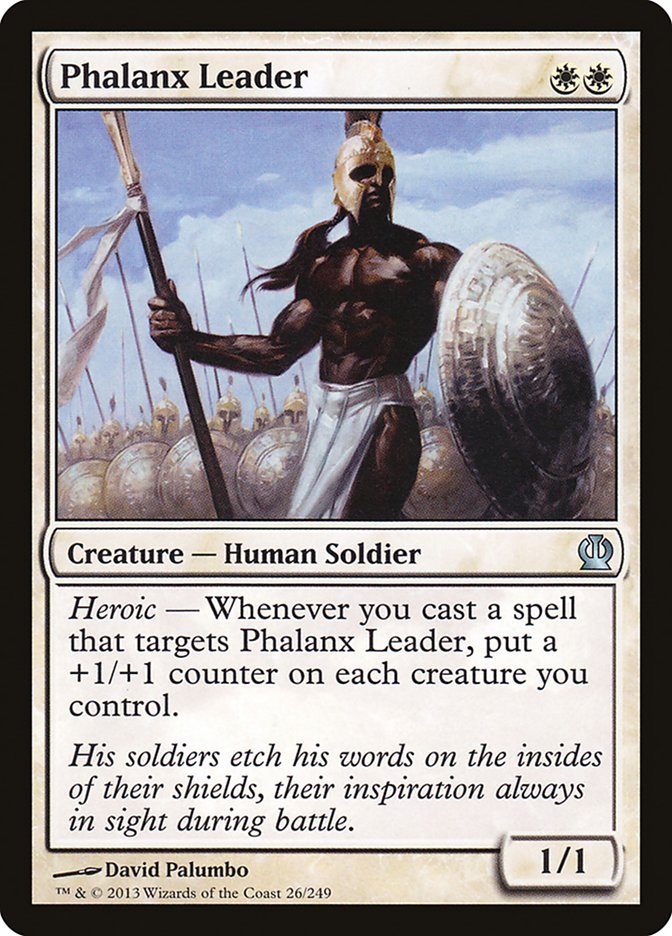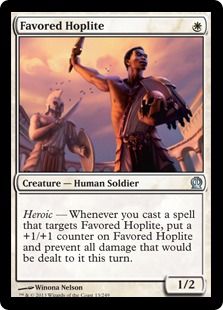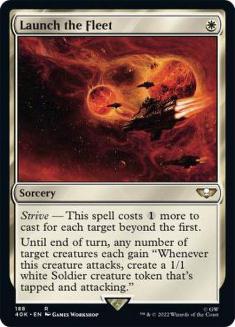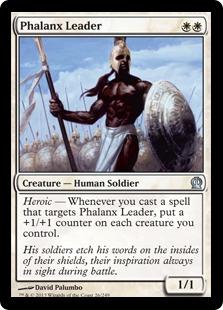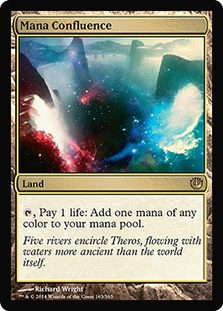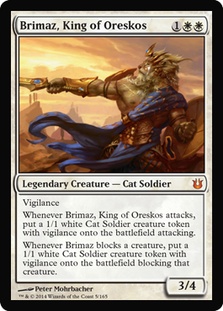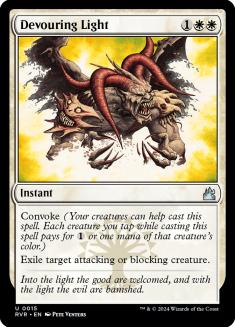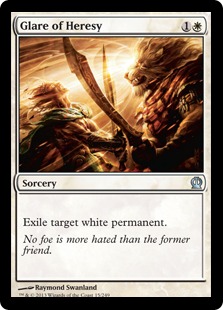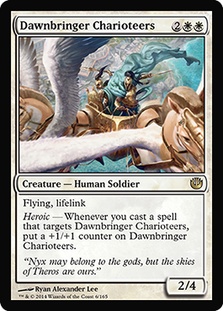If you’ve been following my Standard exploits, then you know I’ve been all about that Sidisi. In the wake of the Pro Tour, however, I wasn’t sure I could
adapt Sidisi to continue working. I loved my matchup against most of the Abzan decks pre-Pro Tour, but I admittedly had some concerns about facing off
against the more planeswalker-laden lists with real sweepers. Elspeth was no problem, but Ajani was an interesting threat that could help them keep up, and
Duneblast or Mass Calcify could be very dangerous for me.
I also didn’t like seeing all those Perilous Vaults. My gameplan against control decks leaned pretty heavily upon Rakshasa Deathdealer and Pharika, God of
Afflictions giving me very resilient threats in a game going long, and the Vault handled them in addition to everything else I might be doing. I could
adjust to account for the card, but trying to sideboard against Vault, Duneblast, and the Ascendancy combo deck wasn’t too exciting.
Thus I decided a change might be in order.
Seeing Red
I started looking at aggressive red decks a la Tom Ross, and they were very powerful. Their game 1s were great essentially across the board, and the
addition of Coordinated Assault was giving me a ton of game in the mono-creature midrange format that Standard had become. I was actually quite excited
about the deck, and I had it sleeved up for most of the week.
There were certainly issues. Anger of the Gods and Drown in Sorrow were both pretty powerful weapons against me, with Anger being the most troublesome by
far. Yet it was somehow less threatening because most of the decks playing it were otherwise very easy matchups to handle. Still, many games were all about
just jamming them and dodging it, as trying to smallball an opponent who was threatening to sweep you might give them the time to legitimately just beat
you.
However, there hadn’t been a lot of successful tiny creature aggro in Hawaii. What’s more, the midrange decks were going to drain sideboard slots, and many
players might be tempted to go trimming. The other archetype that merited sweepers, Green Devotion, had also had a bad weekend, and Hornet Queen wound up
getting much less air time than expected. I didn’t mind the sound of that field, and here’s the red deck I was considering:
Creatures (21)
- 4 Frenzied Goblin
- 4 Foundry Street Denizen
- 4 Akroan Crusader
- 1 Arena Athlete
- 4 Satyr Hoplite
- 4 Monastery Swiftspear
Lands (17)
- 17 Mountain
Spells (22)

Holding Out For a Hero
However, I’d also been impressed by Yoshihiko Ikawa’s R/W Obelisk of Urd deck.
Creatures (15)
Lands (21)
Spells (24)

He’d gone 7-3 in Standard at the Pro Tour, and I’d previously tested similar decks myself when Obelisk first came out. What I hadn’t given much thought to
was that Defiant Strike out of Khans essentially gave you an extra Dragon Mantle, admittedly with pros and cons. In fact, the deck could at times bear a
startling resemblance to the red deck above–an aggressive swarming strategy that was very resilient to attrition-based removal and could create favorable
combat against midrange green decks.
I played a few matches to try it out and eventually decided that the deck was worse than most Boss Sligh lists in game 1, but much more resilient in
sideboarded games and capable of actually maneuvering around what the opponent might be doing. Because of Obelisk, you really could play around sweepers
quite well by presenting just one or two threats until they were willing to really start fighting back. The cards were (generally) of a higher individual
power level, and Gods Willing also appeared to be excellently placed. My roommate had tested Yuuya’s list a bit, and it was a card the consistently
impressed in a general fashion.
I called the audible before the Grand Prix. I liked both decks a lot, but the heroic deck was a little more dynamic and would pressure opponents in unique
ways. Here’s the list I decided to play:
Creatures (16)
Lands (20)
Spells (24)

I’ll go over my differences from Ikawa’s list.
First off, 21 lands was excessive for the maindeck configuration. It made sense because Ikawa had a number of four drops in the sideboard, but if you only
want that extra land in sideboarded games then it makes sense to also sideboard the land. Our own Brad Nelson implemented this exact strategy in his Pro
Tour deck, in fact, with Wind-Scarred Crag.
The land to cut was easy–the second Mountain. Mountain was the worst land in the deck by far, and under essentially no circumstances would you ever want
to draw two copies. I cut the second Mountain immediately, replacing it with a Plains in the sideboard. In addition to adding lands, I’d often switch the
Plains in for the Mountain or Confluence depending upon the opponent and whether I was on the play or the draw. I still wasn’t keen on the singleton
Mountain main though. I didn’t want to drop below thirteen red sources, leaving me to decide between Wind-Scarred Crag or another Plains and risking mana
screw. My personal tiebreaker was the weakness of taplands in general in this strategy and the desire to cast turn 1 Akroan Crusader when I wanted to.
In hindsight, I wished I hadn’t. I think Mountain was the third-best option; I lost more games to drawing it instead of any other land than I think I’d
have lost if it came into play tapped, but realistically the Plains was probably the best call. Getting screwed on red a bit wouldn’t be so bad, especially
because my sideboarded games actually involved avoiding turn 1 Akroan Crusader in many situations. Crusader is the most vulnerable opening against Drown
and Anger, so I often hold it in order to generate value by using it somewhat like Raise the Alarm–a source of multiple tokens that can attack following a
sweeper or a flurry of removal spells. Because so many of your heroic enablers draw a card, these Soldiers are essentially free.
I added a Brimaz to the deck to free up some sideboard slots. Brimaz is a sweet enough card, and I knew I wanted access to four in my sideboarded games
because he’s your best possible turn 3 against an opponent planning to drop Anger of the Gods on your early game. It’s possible that this sideboard
configuration is just better than the maindeck one though! Phalanx Leader was very mediocre across the weekend, essentially operating as bait for removal.
Akroan Crusader and Vanguard are both much more valuable in the average game 1, while Leader can’t grow your creatures outside of Drown or Anger range
frequently enough in sideboarding to make that worthwhile. In fact, I had played a bit awkwardly on occasion in order to avoid Leader’s trigger and Obelisk
“accidentally” making my creatures large enough to let an Elspeth claw my opponent out from behind. It’s an angle worth exploring, as Leader was my worst
spell all weekend.
The mix on Gods Willings and Presences worked fine. I could see making room for a second copy of Presence, as the boost and strive both came up multiple
times for me. I wouldn’t sideboard the card as Ikawa did, however–it’s not high impact enough to matter in that capacity. Maindeck or bust!
Most of my adjustments came to the sideboard. Following the Pro Tour, it was clear Glare of Heresy would be making waves. It kills the two premier threats
of both Abzan and Jeskai (Siege Rhino and Mantis Rider, respectively), eliminates Banishing Light, and several of the format’s better planeswalkers are
vulnerable. It even forces Jeskai Ascendancy to try and go off all at once rather than resolve Ascendancy beforehand! Knowing there’d be more Glares and
Erases in Los Angeles than there had been in Hawaii, I wasn’t at all interested in Suspension Field. I replaced those with my own Glares and drew them
almost never–but they were always awesome when I did!
I almost cut Devouring Light on sight, seeking something more proactive, but then I realized that Brimaz was essentially a ritual effect for the card and
got back on board.
Purphoros made sense as a tool against control decks and Green Devotion, the latter of which sounded like a nightmare, but I think the control matchup is
just good when played correctly. I’m not wholly convinced that Purphoros is better than Iroas if you’re just worried about Green Devotion. Not only can he
actually battle, but Iroas would be a very reasonable card against Abzan and let you adjust the board plan a bit.
I added a Charioteers because it seemed plausibly decent against Jeskai, and I expected to see a decent number of red decks assuming my own logic for
playing them had made sense. Given the composition of the Top 8 and the matches around me, I didn’t regret going to three copies, but I also played against
two Jeskai decks and no red decks, so it didn’t really pay off. Bumping back down to two here is totally reasonable; I’m not sure that the third will pay
large enough in the metagame anyway.
Grand Prix Los Angeles
The tournament went reasonably for me. Here’s my account of the whole shebang:
Round 3: Mardu Aggro, 2-0
Round 4: Abzan Midrange (Ari), 1-2
Round 5: Abzan Aggro, 2-0
Round 6: Jund Midrange, 2-0
Round 7: Sultai Delve (Glenn), 2-0
Round 8: Sultai Delve (Brad), 2-0
Round 9: Abzan Aggro, 2-0
Round 10: Jeskai Aggro, 0-2
Round 11: Jeskai Aggro, 0-2
Round 12: Abzan Midrange (Ari), 2-1
Round 13: Abzan Aggro, 2-0
Round 14: R/W Aggro (Brad), 2-1
Round 15: G/B Devotion, ID
I finished Day 1 on 8-1, taking a loss to Abzan as a result of flooding out and making the error of sideboarding in Purphoros for game 3. Almost any
creature would’ve won me that game, but I’m lighter after sideboarding already, and Purphoros plus the additional land made things worse.
For context, here’s how I was sideboarding:
Out:
In:
Favored Hoplite comes out against essentially anyone playing green. It takes multiple triggers to get it past Courser of Kruphix, in contrast to Boss
Sligh’s ability to Titan’s Strength Satyr Hoplite, and it’s an easy target for black and white-based removal that doesn’t add much value when targeted,
whether you can save it or not. Launch is similarly awkward against green decks, as you essentially have to suicide multiple creatures to turn it on but
also get blown out by Drown without an Obelisk (which is usually enough regardless). I’d generally rather conserve spells to army-in-a-can my opponent than
to trigger Phalanx Leader. That said, I don’t mind having access to one of each, as they can have their moments.
In sideboarded games, I basically try to play a midrange deck: removing the things in my way and building my board presence while playing around Hero’s
Downfall and Bile Blight. When you play this way, you very naturally make Drown in Sorrow mediocre, which is convenient. I had multiple opponents cast
Drown in Sorrow in order to scry away a bad card with Courser, killing nothing!
As you can see, the Abzan matchup is pretty good. I went 9-3 in games including a match in which I just boarded completely wrong for two of those losses!
Day 2 started rough, with a pair of very close losses to Jeskai. The first was to Austin Bach, who won when my Mountain showed up in both games to keep me
from being able to lethal him the turn before he could burn me out, which was quite frustrating. I was so annoyed that I actually tore that Mountain in
half and grabbed some new ones from the land station! The second loss was to Craig Wescoe, with a very close game 1 before I had a mediocre draw in game 2.
I thought the matchup was favorable going into the event, but it may be closer than I’d originally surmised. I’m still not quite sure how to sideboard it,
but here’s where I’m currently at:
Out:
In:
Obelisk is really mediocre against Anger of the Gods, but it can also just be mediocre in general because the matchup is so fast-paced that taking a turn
off to cast it can leave you dead. It might seem weird, but I think I’m supposed to be the control deck, sort of? Their removal is bad against my plan for
beatdown, so if I can keep myself alive I’m a substantial favorite. Keeping that in mind, I want to find room for the third Light and third Charioteers, I
think, but I am uncertain.
On the play, I might keep something closer to the maindeck and just try to gun it and get them, but it depends a bit on their choices as well given the
possibility that they also transform in sideboarding.
You can see why I think it might be right to just main those Brimaz and maybe some Lights…
My fourth loss came against Brad’s deck from the Pro Tour, R/W Aggro. Hordeling Outburst is everything I don’t want to see in a card, and Goblin
Rabblemaster is similarly troublesome considering the removal backing it. Lightning Strike and Magma Jet are pretty efficient, but Chained to the Rocks
really gives the opponent a ton of initiative in the matchup. I think losing the die roll is huge in this matchup, but I also expect it to become much less
common so I’m not too concerned.
I was quite excited to draw into Top 100 against G/B Devotion, as that matchup sounds like my worst possible by a long shot. Repeatable sweeper effects,
tutorable Reclamation Sages, Polukranos… yuck.
If you’re looking for a fun Standard deck, I can heartily recommend this one. It’s enjoyable and challenging to play and very dynamic; figuring out when to
hold spells and when to flood the board is tough, and knowing which spells to play when is also huge. Practice a ton, as I was very much taking my time and
had prior experience to fall back on, but I landed in some very tight spots! This weekend I’ll be playing in the TCGPlayer 50k in Indianapolis, and while
I’m not sure if I’d run this deck back, I do know it’s on my radar.

